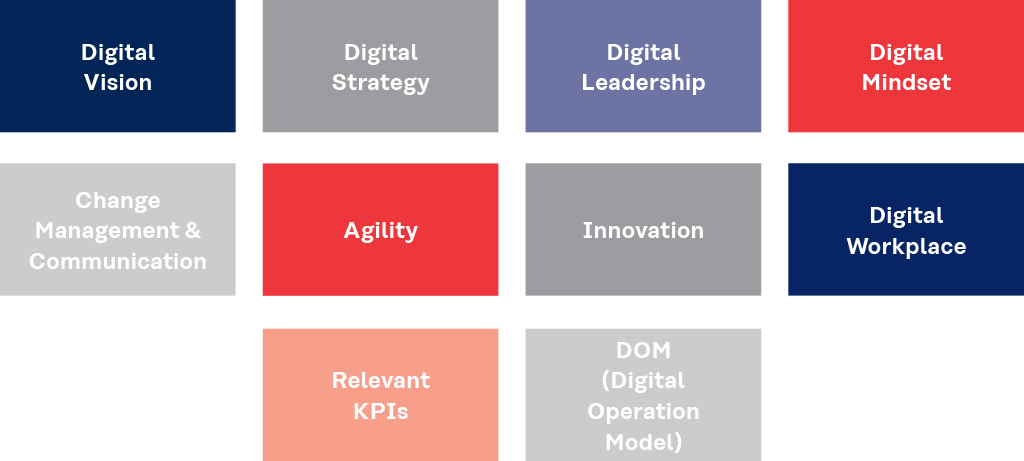Roadmap to the future
Preparing your company for digital transformation
In the last issue of Report, you could read about how digital transformation was leading the world of print into the future, how digital tools were altering business processes, producing new service offers and even heralding a cultural transformation. In this second article, Thomas Göcke, head of digitalisation & marketing at Koenig & Bauer in Radebeul, explains the “ingredients” and steps which are necessary to make digital transformation successful.
In contrast to digitisation, which refers merely to the use of digital technologies, digital transformation describes an entire process by which new business models are created and a 100% customer-centric focus can be established. Enhanced technical possibilities lay the foundations for new offers to customers, new markets and a whole new culture, combining operative processes, the customer experience and digital business goals.
Visions for change
Every digital business transformation begins with a vision, which must subsequently be implemented in a digital agenda. The most important ingredients are shown below:

First of all, there are questions to be answered regarding the digital vision:
- Why are we seeking digital transformation? We need to know why we are following a certain path to be able to motivate employees and customers to join us on that journey.
- How is our vision derived from our current business model? How can our employees, customers and business partners understand the step as consistent further development?
- Which convincing arguments are supplied by our digital vision and which concrete objectives are identified?
- How can our vision be communicated in all areas and on all levels of the company?
- How do employees, customers and business partners view our vision?
- How open is our vision to new developments and change?
The answering of these questions triggers changes in many processes and even the prevailing culture within the company. The same can be said of its structures and organisation, as well as the alignment of IT resources to the new activities. The company treads new paths in the elaboration of solutions. Digital mindsets are brought to the fore.
McKinsey once framed it as follows: “Companies that successfully adopt digital technology don’t view it as an extra; digitisation becomes central to what they are, because they transform their value propositions and evolve every level of the organisation so that it becomes data-driven, customer-obsessed and highly agile.”
Agility, innovation and a digital work environment
Agility begins in the mind. One milestone by which the basic feasibility of a project can be demonstrated is a proof of concept, preferably as the product of an interdisciplinary team. This minimises the risk in the decision and tests the acceptance of an application in the cooperation with manufacturers and partners. The “fail and learn” approach can be implemented with just a few, clearly defined resources. Existing components can be re-used. Open and intensive knowledge exchange follows.
Digital workplaces are an imperative prerequisite for the development of digital mindsets. After all, innovation, speed and cooperation, often transcending national borders and cultures, call for new approaches to work. Flexibility in the organisation of working time requires mobile tools, for example modern collaboration tools. The majority of employees see the digital workplace as an opportunity to improve their work-life balance.
The success of transformation must be measurable by way of key performance indicators (KPIs) defined in advance. Typically, it will be increased customer and employee satisfaction which is measured. But a reduced time-to-quote value and higher cross- and upsell rates in sales and service, improved forecast accuracy or a higher first-time fix rate / first-call resolution (FTR) in service are also targets to be considered.
Is it feasible or not?
What must be done before setting off on the road to digital transformation? First of all, there should be a reality check. This covers organisation and clarification of the required budget, as well as the elaboration of digital visions and strategies. At the same time, lighthouse projects must be selected and started without delay, and the corresponding KPIs must be defined. This, in turn, must be followed up with methods, tools and mindsets supportive of the concept of a digital workplace. Internal marketing/change management must be lived actively and a roadmap for the digital transformation must be implemented.
Lessons learned:
- Digital transformation is not a cost factor, it must generate constant added value
- Digital transformation is not a one-off project, but rather a process of continuous change
- Digital transformation is not a crash diet, but rather long-term dietary adjustment
- Technology alone is just make-up, it is the inner values which count
- Digital transformation cannot be bought
- and last but not least …

Thomas Göcke
